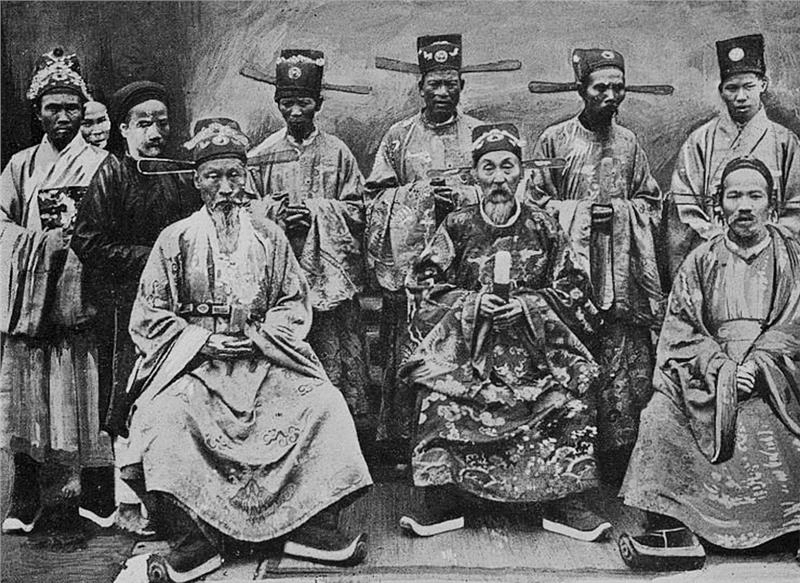Nguyen (Nguyễn) is the most common Vietnamese family name. By some estimates, approximately 40 percent of Vietnamese have this surname. The prevalence of Nguyen as a family name in Vietnam extends to outside of the country where many Vietnamese have emigrated. Nguyen is the 7th most common family name in Australia, and the 54th most common in France. In the United States, it is the 57th most common family name according to the 2000 Census, as well as the most common exclusively Asian surname. The Nguyen Dynasty which was the last Dynasty of Vietnam is the main reason for that.
Here are the two of the reasons: Firstly, the regular Vietnamese did not have family names in ancient times because only the aristocratic nobles had them. By the time the Nguyen Dynasty ruled Vietnam, the Nguyen Vietnamese would have many privileges from the court according to their laws. A large number of the Vietnamese therefore changed their name to Nguyen. Secondly, the French launched an unprecedented census in Vietnam in the early 19th Century, but many people who had no surname which made difficult for statistics, that’s why Nguyen has been deliberately selected for many Vietnamese by the French.
The last imperial family of Vietnam.
Their ancestral line can be traced back to the beginning of the Common Era. However, only by the mid-sixteenth century the most ambitious family branch, the Nguyen Lords had risen to conquer, control and establish feudal rule over large territory. Imperial rule lasted for 143 years, when Gia Long ascended the throne in 1802, after putting an end to the rise of the Tây Sơn and uniting the country, Emperor Bảo Đại, the dynasty’s last representative abdicated the throne and transferred sovereign power to the Democratic Republic of Vietnam in 1945. Nguyen dynastic rule was obtained by the support of the French, who compromised its authority from the beginning. Sovereignty was eventually lost to French colonialism as the nation was divided into three administrative entities of French Indochina: Cochinchina (became a French colony), Annam and Tonkin (became nominally-independent protectorates).
During the rule of the Nguyen dynasty, Vietnam was renamed for twice: The Kingdom of Vietnam (1802-1839); The Empire of Dai Nam (1839-1945) and Hue city was the capital of the whole time.
The list of Nguyen Emperors:
1. GIA LONG
(Nguyễn Phúc Ánh 1802-1820): Unified and named Vietnam, founded its last dynasty
2. MINH MẠNG
(Nguyễn Phúc Đảm 1820-1841): Annexed the remaining Panduranga kingdom, renamed Vietnam Đại Nam (Great Nam/Great South), suppressed religion
3. THIỆU TRỊ
(Nguyễn Phúc Miên Tông 1841-1847): Kept the old rules and followed the predecessor’s instructions.
4. TỰ ĐỨC
(Nguyễn Phúc Hồng Nhậm 1847-1883): Faced French invasion and ceded Cochinchina to France
5. DỤC ĐỨC
(Nguyễn Phúc Ưng Ái 1883): Three-day emperor (20–23 July 1883)
6. HIỆP HOÀ
(Nguyễn Phúc Hồng Dật 1883): Four-month emperor (30 July – 29 November 1883)
7. KIẾN PHÚC
(Nguyễn Phúc Ưng Đăng 1883-1884): Eight-month emperor (2 December 1883 – 31 July 1884)
8. HÀM NGHI
(Nguyễn Phúc Ưng Lịch 1884-1885): Dethroned after one year, continuing his rebellion until was captured in 1888 and fled to Algeria
9. ĐỒNG KHÁNH
(Nguyễn Phúc Ưng Kỷ 1885-1889): Helped France establish colonization in Vietnam
10. THÀNH THÁI
(Nguyễn Phúc Bửu Lân 1889-1907): Exiled to Réunion island after 18 years as an emperor
11. DUY TÂN
(Nguyễn Phúc Vĩnh San 1907-1916): Became the emperor as 8 years old. Exiled to Réunion island with his father in 1916
12. KHẢI ĐỊNH
(Nguyễn Phúc Bửu Đảo 1916-1925): Collaborated with the French, and was a political figurehead for French colonial rulers. Unpopular with the Vietnamese people, nationalist leader Phan Châu Trinh accused him of selling Vietnam to the French and living in imperial luxury while the people were exploited.
13. BẢO ĐẠI
(Nguyễn Phúc Vĩnh Thuỵ 1925-1945): Created the Empire of Vietnam under Japanese occupation during World War II; abdicated and transferred power to the Viet Minh in 1945, ending the Vietnamese monarchy. Removed as head of state of the State of Vietnam, changing it to a republic with Ngô Đình Diệm as president. Unpopular, considered an impotent puppet of the French colonial regime.
The UNESCO’s World Heritage Site
As the nearest feudal system, the Nguyen Dynasty had great influence to Hue city, its former capital. The city is well known for its historic monuments, which have earned it a place in UNESCO’s World Heritage Sites in 1993. Hue Citadel and the Imperial Tombs are the most outstanding landscape remaining. In addition, Hue royal cuisine is also a must try food experience for any traveler, or the Hue Royal Court Music which was usually performed on the boat. Travelers could enjoy these special features by taking Hue tours with JPTraveltime
(Justin Ngoc Pham)


